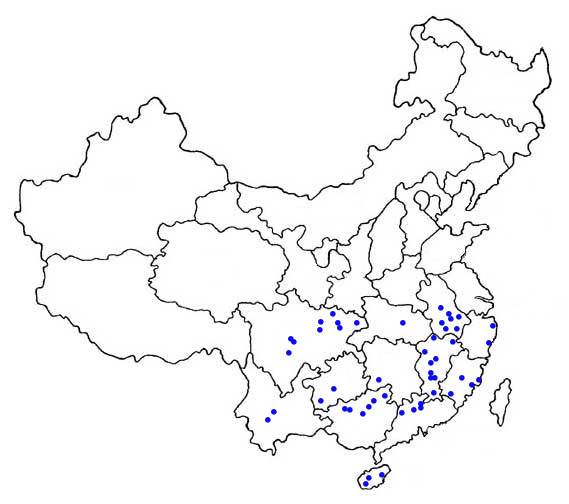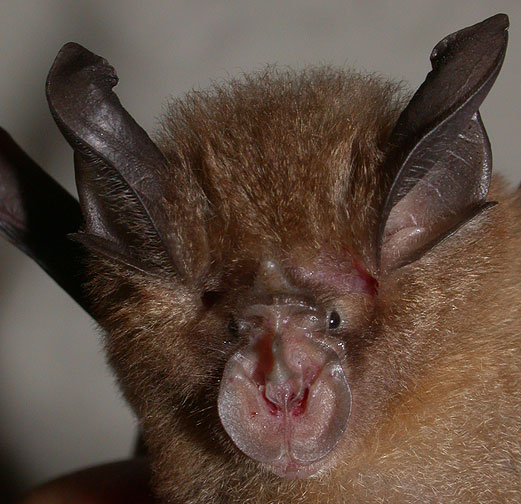Rhinolophus pusillus
Least Horseshoe Bat; Blyth's horseshoe bat
Morphological description Life history Distribution Habitat Roost sites and roosting patterns Emergence and flight pattern Foraging behaviour Echolocation calls Status and protection
Morphological Description
· Dorsal fur is dark brown. Ventral fur is white-grey.
· Juveniles are greyer than adults.
· It is a very small horseshoe bat. Forearm length 33.5-40.0mm. (Csorba et al. 2003). Forearm lengths in China averaged 36.9 +/- 1.4 mm (SD) for males (n = 17; range 35.1-40.2 mm); 37.2 +/- 1.5 mm for females (n = 8, range 34.9-40.2 mm) (Li et al. 2006).
· The horseshoe is relatively wide. The sella is constricted in the middle, gradually narrow to a widely rounded tip. (Csorba et al . 2003). In lateral view the sella shows a concavity and the connecting process is triangular or horn-shaped.
· Lower lip has 3 mental grooves.
· Body mass of 5 individuals ranged between 4.3 - 5.2 g.
· In terms of its echolocation call frequencies and body size, R. pusillus is very similar to R. monoceros from Taiwan and R. cornutus from Japan. These taxa form a monophyletic group in a phylogenetic tree, and sequence divergence values among R. pusillus from China are greater than those between R. pusillus and the other two taxa. Overall, there appears to be a lack of taxonomic distinctiveness among these taxa, which are all closely related to one another and could be considered as a single species. The bats are phylogenetically distinct from the morphologically similar R. hipposideros from Europe however, which problems has evolved to look similar by convergent evolution (Li et al. 2006).
Life history
· Little known
Distribution
Apparently ranges through India, Nepal, Myanmar, Vietnam, Thailand, Malaysia and Indonesia (Csorba et al. 2003). The Chinese distribution is shown by the dots on the map below (as given by Zhang et al . 1997).

Habitat
· Little known.
Roost sites and roosting behaviour
· Generally roosts in caves, often with other species. Also recorded in the roof of bungalow in forest. (Csorba et al ., 2003).
Emergence and flight pattern
· Most rhinolophid bats have wing shapes that make them adept at foraging in cluttered environments.
Foraging behaviour
· Analysis of droppings from Beijing area by GJ showed the diet to comprise (mean +/- SD, by volume) 45.0 +/- 33.2% Diptera; 41.5 +/- 27.2% Lepidoptera; 13.5 +/- 14.6% Coleoptera (5 droppings analysed from each of 2 bats; bats captured 10July, 10 droppings from under roost, near Beijing). The diet therefore resembles that of the morphologically similar (but phylogenetically distant) R. hipposideros from Europe which also eats mainly small dipteran flies and moths (Vaughan 1997).
Echolocation calls
The echolocation call is a long constant frequency signal, with a brief frequency-modulated start and tail. Frequencies with most energy recorded from hand-held bats ranged between 102-111 kHz (n = 24). Averages for males were 105.95 +/- 2.72 (SD) kHz (n = 8) , while females called with most energy at 108.48 +/- 2.57 kHz (n = 5) (Li et al. 2006).
To listen to the call of the least horseshoe bat click here
Size of sound file: 324 kb
Status and protection
· There is no estimation of population size in China.
· Least horseshoe bats are LR/lc, assessed by the Red List of Threatened Species (IUCN, 2006) The species is not listed in the Law of the People's Republic of China on the Protection of Wildlife in 1989.
· Caves and old buildings should be protected as roost sites.
